Sedimentary rocks formed weathering erosion and deposition tell fascinating stories of Earth’s history. Understanding how these rocks are created, from the initial breakdown of bedrock to the final layering of sediment, is key to appreciating the landscapes around us, and rockscapes.net provides a wealth of knowledge to guide you. So, let’s dive into the dynamic processes of weathering, erosion, deposition, and lithification, which are essential for the formation of these rocks. This knowledge can help with landscape design, rock selection, and construction techniques using sediment layers, surface sediments, and rock sediment, creating a beautiful landscape.
1. What is Weathering and How Does It Start the Process of Sedimentary Rock Formation?
Weathering is the breaking down of rocks, soils, and minerals through direct contact with the Earth’s atmosphere. Weathering is the initial step in the process of forming sedimentary rocks, transforming solid bedrock into smaller particles. It occurs through mechanical weathering, physically disintegrating the rock, and chemical weathering, altering the rock’s chemical composition.
1.1. Mechanical Weathering: Breaking Rocks Apart
Mechanical weathering involves the physical disintegration of rocks into smaller pieces without changing their chemical composition. The main agents of mechanical weathering include:
- Pressure Expansion: As bedrock is brought to the surface through uplift and erosion, the reduction in pressure causes it to expand and crack. This is also known as exfoliation, where the rock surface peels off in layers.
- Frost Wedging: Water enters cracks in rocks, and when it freezes, it expands, exerting pressure that widens the cracks. Repeated freeze-thaw cycles eventually break the rock apart.
- Root Wedging: Plant roots grow into cracks in rocks, and as they expand, they exert pressure that pries the rocks apart. This process is similar to frost wedging, but with plant roots.
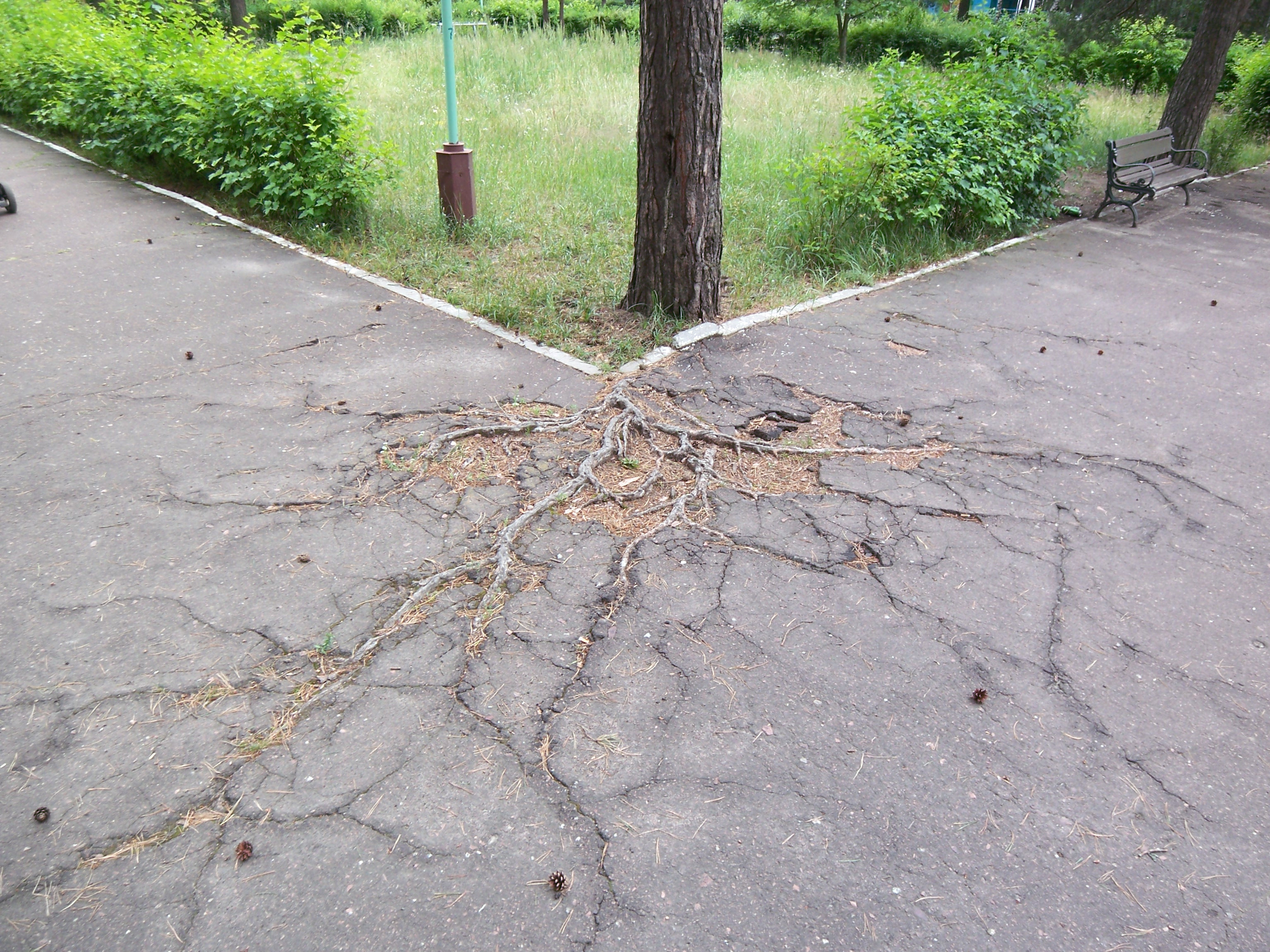 The roots of the tree are breaking up the asphalt.
The roots of the tree are breaking up the asphalt.
Alt text: Tree roots demonstrating the destructive power of root wedging on asphalt, similar to its effect on natural rock.
- Salt Expansion: In areas with high evaporation rates or near marine environments, salt crystals precipitate out of solution and grow in cracks in rocks, exerting pressure that widens the cracks. Salt expansion can lead to the formation of tafoni, a series of holes in a rock.
1.2. Chemical Weathering: Altering Rock Composition
Chemical weathering involves the chemical alteration of rocks, transforming their mineral components into water-soluble ions. The main agents of chemical weathering include:
-
Carbonic Acid and Hydrolysis: Carbon dioxide dissolves in water to form carbonic acid, which reacts with minerals in rocks, breaking them down. According to Arizona State University’s School of Earth and Space Exploration, in July 2025, Hydrolysis, a reaction with water, is particularly effective in breaking down silicate rocks, leading to the formation of clay minerals.
-
Dissolution: Minerals in rocks dissolve in water, leaving ions in solution. Certain minerals, such as evaporites and carbonates, are more prone to dissolution, but all minerals can be dissolved over time.
-
Oxidation: Iron atoms in minerals bond with oxygen, forming iron oxides, such as hematite, goethite, and limonite. These iron oxides can permeate rocks or form coatings, often giving them a reddish or brownish color.
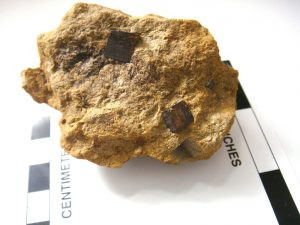 Goethite is in cubes, though it usually is not. Pyrite is in cubes.
Goethite is in cubes, though it usually is not. Pyrite is in cubes.
Alt text: Oxidized pyrite cubes transforming into goethite, showcasing the chemical alteration of minerals.
1.3. The Combined Effect of Mechanical and Chemical Weathering
Mechanical and chemical weathering work together, enhancing each other’s effects. Mechanical weathering increases the surface area of rocks, making them more susceptible to chemical weathering. In turn, chemical weathering weakens rocks, making them more vulnerable to mechanical breakdown. The interplay of these processes leads to the efficient breakdown of bedrock into sediment.
2. What is Erosion and How Does it Transport Sediment?
Erosion is the process by which sediment is carried away from its source by natural agents such as water, wind, ice, and gravity. Erosion is a mechanical process crucial for transporting sediment from weathering sites. The type of erosion and the distance sediment travels influence the characteristics of sedimentary rocks.
2.1. Water Erosion: The Primary Agent of Transport
Liquid water is the most significant agent of erosion. It transports sediment through various means:
- Rivers and Streams: Rivers carry sediment downstream, ranging from fine silt and clay to large boulders, depending on the flow velocity and volume of water. The Grand Canyon, with its cliffs made of erosion-resistant rock, demonstrates the powerful effects of water erosion.
- Rainfall: Rainfall can erode soil and rock, especially on steep slopes. The eroded material is then transported by runoff to streams and rivers.
- Coastal Erosion: Waves and currents erode coastlines, transporting sand, gravel, and other sediment. This is a constant process that reshapes coastlines over time.
2.2. Wind Erosion: Transporting Fine Particles
Wind erosion is particularly effective in arid and semi-arid regions, where it can transport fine particles over long distances.
- Dust Storms: Strong winds can pick up and transport vast amounts of dust, creating dust storms that can carry particles hundreds or thousands of miles away. According to research from Arizona State University’s School of Earth and Space Exploration, in July 2025, dust storms not only erode landscapes but also impact climate and air quality.
- Sand Dunes: Wind transports sand grains, forming sand dunes. These dunes can migrate over time, reshaping landscapes and burying features beneath them.
2.3. Ice Erosion: Moving Large Rock Fragments
Ice, in the form of glaciers, is a powerful agent of erosion, capable of transporting large rock fragments and fine sediment.
- Glacial Erosion: Glaciers erode bedrock through abrasion and plucking, incorporating rock fragments into the ice. As the glacier moves, it carries these fragments along, depositing them as till when the ice melts.
- Glacial Transport: Glaciers can transport large boulders and fine sediment over long distances, creating unique geological features such as moraines and eskers.
2.4. Gravity Erosion: Mass Wasting
Gravity plays a crucial role in erosion through various mass wasting processes, where rocks and sediment move downslope under the influence of gravity.
- Landslides: Rapid downslope movement of large masses of rock and soil.
- Mudflows: Flows of water-saturated sediment, often triggered by heavy rainfall.
- Creep: Slow, gradual downslope movement of soil and rock.
3. What is Deposition and How Does Sediment Accumulate?
Deposition occurs when the transporting agents (water, wind, ice, gravity) lose energy and can no longer carry the sediment. Deposition is the process by which sediment settles and accumulates in a new location. The conditions and environment of deposition influence the type of sedimentary rock formed.
3.1. Deposition in Aquatic Environments
Aquatic environments are the primary sites of sediment deposition.
- Rivers and Streams: As rivers flow into lakes or oceans, they lose energy, depositing sediment. Coarse sediment settles first, followed by finer sediment, creating layered deposits.
- Lakes: Lakes are relatively calm environments where fine-grained sediment can settle and accumulate, forming mudstones and shales.
- Oceans: Oceans are vast depositional environments where a variety of sediments accumulate, including sand, silt, clay, and biogenic materials. These sediments form sandstones, siltstones, shales, and limestones.
3.2. Deposition in Terrestrial Environments
Terrestrial environments also serve as depositional sites, though often less continuously than aquatic settings.
- Deserts: Wind transports sand and silt in deserts, forming dunes and loess deposits.
- Glacial Environments: Glaciers deposit till and outwash sediments as they melt, creating moraines, eskers, and other glacial landforms.
- Alluvial Fans: Streams flowing out of mountains deposit sediment on alluvial fans, forming coarse-grained conglomerates and breccias.
3.3. Factors Influencing Deposition
Several factors influence the deposition of sediment:
- Energy of the Transporting Agent: Higher energy environments, such as fast-flowing rivers, can transport larger sediment grains. Lower energy environments, such as lakes and oceans, favor the deposition of fine-grained sediment.
- Sediment Size and Density: Larger and denser sediment grains settle more quickly than smaller and less dense grains.
- Chemical and Biological Processes: Chemical precipitation and biological activity can also contribute to deposition, such as the formation of limestone from the accumulation of marine organisms.
4. Lithification: How Does Sediment Become Solid Rock?
Lithification is the process by which loose sediment is transformed into solid sedimentary rock. This process involves compaction and cementation.
4.1. Compaction: Squeezing Sediment Together
Compaction occurs as sediment accumulates and the weight of overlying material compresses the sediment grains together, reducing pore space and increasing density.
- Overburden Pressure: The weight of overlying sediment creates pressure that forces sediment grains closer together.
- Water Expulsion: Compaction expels water from the pore spaces between sediment grains, further increasing density.
4.2. Cementation: Gluing Sediment Grains Together
Cementation is the process by which minerals precipitate from solution and coat sediment grains, binding them together.
- Precipitation of Minerals: Minerals such as calcite, silica, and iron oxides precipitate from groundwater, coating sediment grains and filling pore spaces.
- Formation of Cement: These precipitated minerals act as a cement, gluing the sediment grains together and forming solid rock.
4.3. Diagenesis: Chemical and Physical Changes
Diagenesis encompasses all the chemical, physical, and biological changes that occur in sediment after deposition and during lithification. According to research from Arizona State University’s School of Earth and Space Exploration, in July 2025, Diagenesis can alter the mineral composition, texture, and structure of sedimentary rocks.
- Mineral Alteration: Unstable minerals may alter to more stable forms.
- Recrystallization: Minerals may recrystallize, changing their size and shape.
- Dissolution and Precipitation: Minerals may dissolve and reprecipitate in different locations.
5. Types of Sedimentary Rocks and Their Formation Environments
Sedimentary rocks are classified into two main categories: clastic and chemical.
5.1. Clastic Sedimentary Rocks: From Weathered Rock Fragments
Clastic sedimentary rocks are formed from fragments of weathered rocks and minerals.
-
Conglomerate and Breccia: These rocks are composed of large, rounded (conglomerate) or angular (breccia) rock fragments cemented together. They form in high-energy environments such as alluvial fans and river channels.
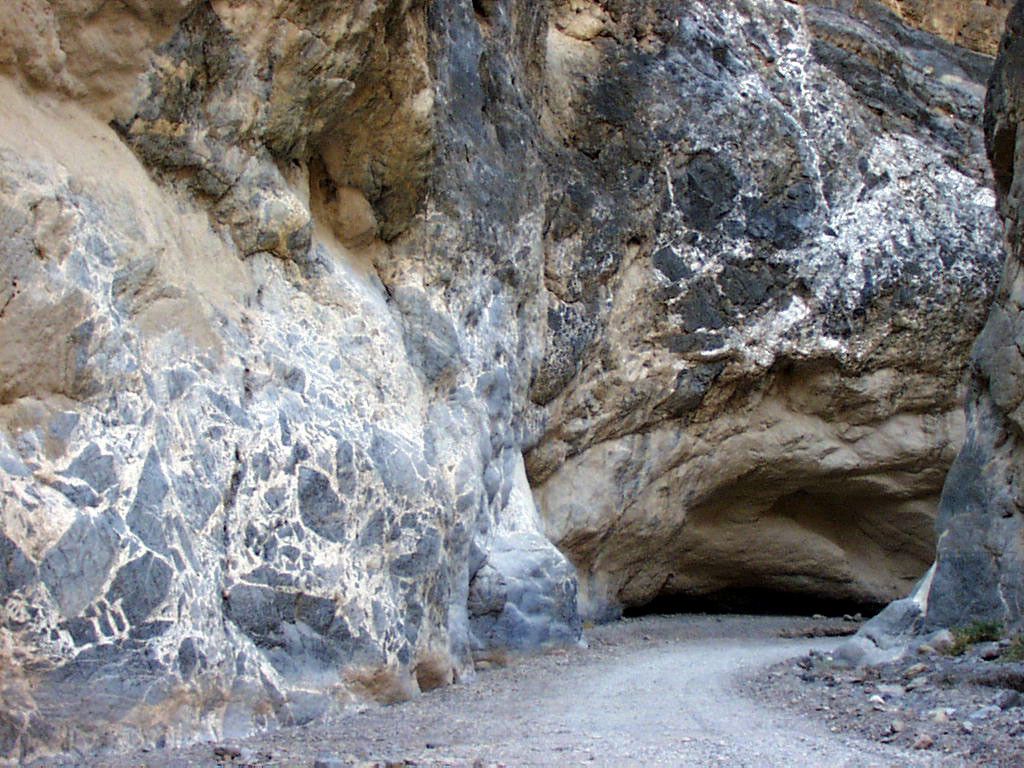 The grey rock is broken and angular within the larger rock.
The grey rock is broken and angular within the larger rock.
Alt text: Megabreccia in Titus Canyon, Death Valley National Park, California, displaying angular rock fragments.
-
Sandstone: Sandstone is composed of sand-sized grains cemented together. It forms in a variety of environments, including beaches, deserts, and river channels. The Coral Pink Sand Dunes State Park, Utah and other locations with rounded windblown sand grains exemplify this.
-
Shale: Shale is composed of fine-grained silt and clay particles. It forms in low-energy environments such as lakes, lagoons, and deep ocean basins.
5.2. Chemical Sedimentary Rocks: From Precipitated Minerals
Chemical sedimentary rocks are formed from minerals that precipitate out of solution.
-
Limestone: Limestone is composed primarily of calcium carbonate (calcite). It forms in marine environments from the accumulation of shells, coral, and other biogenic materials, as well as through chemical precipitation. Timpanogos Cave National Monument provides a great example of this.
-
Rock Salt and Gypsum: These rocks are composed of halite (sodium chloride) and gypsum (calcium sulfate), respectively. They form in evaporite environments where water evaporates, leaving behind dissolved salts. The Bonneville Salt Flats in Utah is another place that has this.
6. Sedimentary Structures: Clues to the Past
Sedimentary structures are features formed during or shortly after deposition that provide clues about the depositional environment.
6.1. Bedding Planes: Layered Deposits
Bedding planes are the boundaries between layers of sediment, indicating changes in depositional conditions. Bedding planes show horizontal strata in southern Utah.
6.2. Cross-Bedding: Ancient Dunes
Cross-bedding is formed by the migration of ripples and dunes, indicating the direction of flow. This is seen in areas such as lithified cross-bedded dunes from the high country of Zion National Park, Utah.
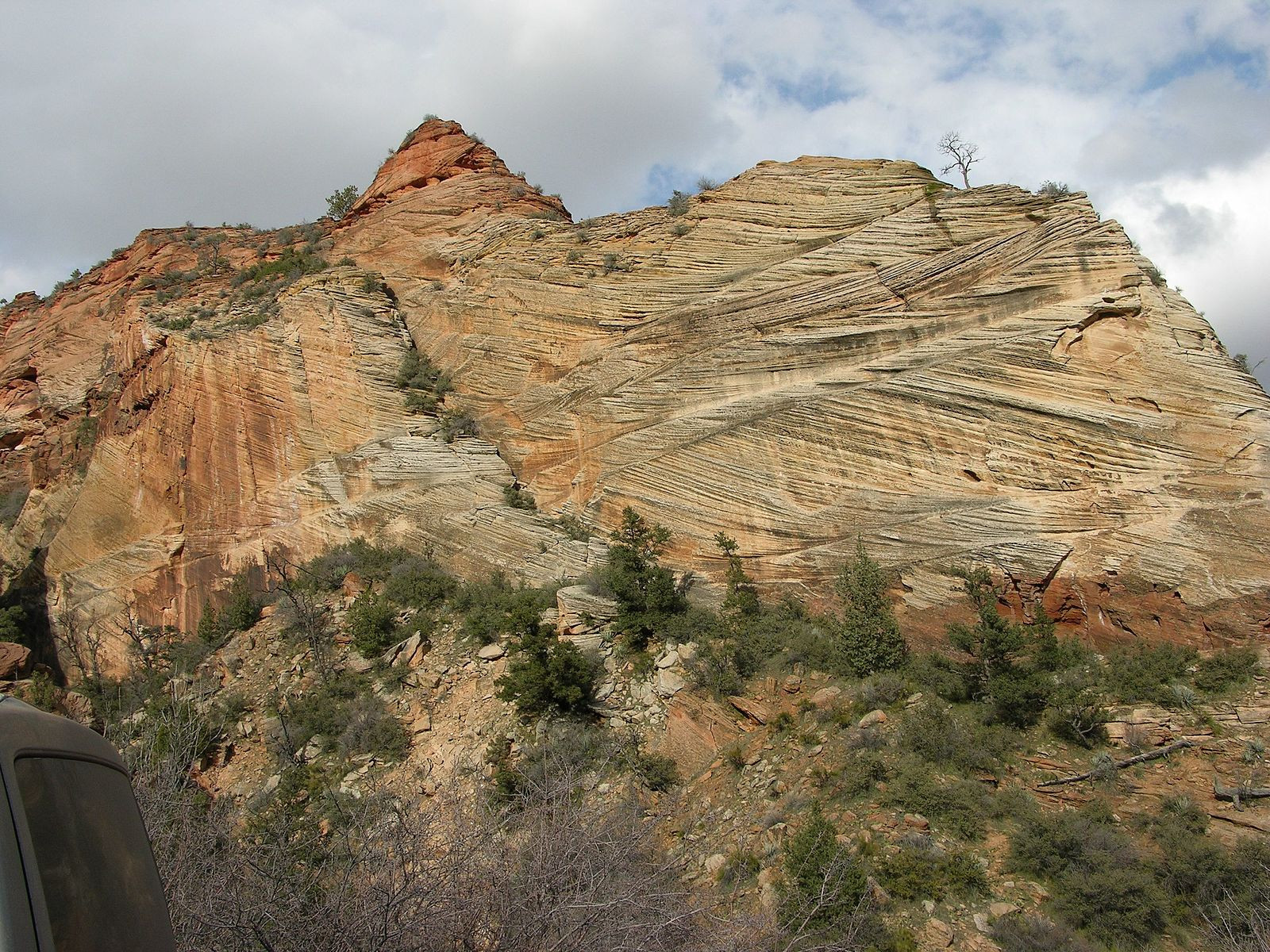 The mountain has a large variety of angles of beds, resulting from dunes moving in all directions.
The mountain has a large variety of angles of beds, resulting from dunes moving in all directions.
Alt text: Lithified cross-bedded dunes in Zion National Park, Utah, showcasing the three-dimensional network of ancient dune flows.
6.3. Ripple Marks: Ancient Water Flow
Ripple marks are formed by the action of water or wind, indicating the direction of flow and the energy of the environment. A bidirectional flow creates symmetrical ripples such as in Mongolia.
6.4. Mudcracks: Ancient Drying
Mudcracks form when clay-rich sediment dries out, indicating alternating wet and dry conditions. Lithified mudcracks can be found in Maryland.
7. Depositional Environments and Rockscapes
Understanding depositional environments is crucial for interpreting the history of landscapes and creating rockscapes that reflect natural processes.
7.1. Marine Environments: Coastal Features
Marine environments, such as beaches, tidal flats, and reefs, create distinct rockscapes characterized by well-sorted sands, mudcracks, and diverse biological structures. Coral Outcrop Flynn Reef and the Kara-Bogaz Gol Lagoon, Turkmenistan are good examples.
7.2. Terrestrial Environments: Mountain and Desert Features
Terrestrial environments, such as rivers, alluvial fans, and deserts, create rockscapes characterized by coarse-grained conglomerates, cross-bedded sandstones, and wind-sculpted features.
7.3. Glacial Environments: High Altitude Features
Glacial environments create rockscapes characterized by poorly sorted tills, striated boulders, and U-shaped valleys. Wide ranges of sediments can be found near Athabaska Glacier, Jasper National Park, Alberta, Canada.
8. Sedimentary Rocks in Landscaping: A Rockscapes Perspective
Sedimentary rocks offer a wide range of options for creating unique and aesthetically pleasing landscapes.
8.1. Selecting the Right Rocks
Choosing the right type of sedimentary rock depends on the desired aesthetic, the local climate, and the intended use. Sandstones and limestones are popular choices for creating natural-looking rockscapes.
8.2. Incorporating Sedimentary Structures
Incorporating sedimentary structures such as bedding planes, cross-bedding, and ripple marks can add visual interest and tell a story about the rock’s origin.
8.3. Building Rockscapes
Sedimentary rocks can be used to build walls, pathways, patios, and other landscape features. Their natural textures and colors blend well with the environment, creating harmonious and sustainable designs.
9. Rockscapes.net: Your Guide to Sedimentary Rocks in Landscaping
Rockscapes.net provides a comprehensive resource for homeowners, landscape designers, and contractors looking to incorporate sedimentary rocks into their projects. Here’s how rockscapes.net can help:
- Inspiring Design Ideas: Explore a gallery of stunning rockscapes featuring sedimentary rocks, showcasing their beauty and versatility.
- Detailed Information: Learn about the properties, characteristics, and applications of various sedimentary rocks, ensuring you make informed choices.
- Practical Tips: Get step-by-step guidance on selecting, handling, and installing sedimentary rocks in your landscape.
- Expert Advice: Connect with experienced landscape designers and stone suppliers who can provide personalized recommendations and support.
10. FAQ: Sedimentary Rocks, Weathering, Erosion, and Deposition
10.1. What is the main difference between mechanical and chemical weathering?
Mechanical weathering involves physically breaking rocks into smaller pieces without changing their chemical composition, whereas chemical weathering alters the chemical composition of rocks, transforming their mineral components.
10.2. How does water contribute to the formation of sedimentary rocks?
Water acts as a primary agent in both weathering and erosion. It helps break down rocks through chemical reactions and transports sediment to depositional environments.
10.3. What are the primary agents of erosion?
The primary agents of erosion are water, wind, ice, and gravity. Water is the most significant agent, but wind, ice, and gravity also play important roles.
10.4. What is the process of lithification?
Lithification is the process by which loose sediment is transformed into solid sedimentary rock through compaction and cementation.
10.5. How are clastic sedimentary rocks classified?
Clastic sedimentary rocks are classified based on their grain size, ranging from coarse-grained conglomerates and breccias to medium-grained sandstones and fine-grained shales.
10.6. What are some common sedimentary structures?
Common sedimentary structures include bedding planes, cross-bedding, ripple marks, and mudcracks, which provide clues about the depositional environment.
10.7. How do depositional environments influence the type of sedimentary rock formed?
Different depositional environments, such as rivers, lakes, oceans, and deserts, have varying energy levels and sediment sources, resulting in the formation of distinct types of sedimentary rocks.
10.8. What are chemical sedimentary rocks and how are they formed?
Chemical sedimentary rocks are formed from minerals that precipitate out of solution. Common examples include limestone, rock salt, and gypsum.
10.9. What is the significance of sedimentary rocks in landscaping?
Sedimentary rocks offer a wide range of options for creating natural-looking and aesthetically pleasing landscapes. Their textures, colors, and structures blend well with the environment, enhancing the beauty and sustainability of landscape designs.
10.10. Where can I find more information and inspiration for using sedimentary rocks in landscaping?
Visit rockscapes.net for inspiring design ideas, detailed information about sedimentary rocks, practical tips, and expert advice.
Ready to transform your outdoor space with the timeless beauty of sedimentary rocks? Visit rockscapes.net today for a wealth of design inspiration, detailed information on different rock types, and expert guidance to bring your vision to life! Discover the endless possibilities and create a landscape that tells a story of the Earth’s rich history. Contact us now for a consultation, and let’s start building your dream rockscape together! Address: 1151 S Forest Ave, Tempe, AZ 85281, United States. Phone: +1 (480) 965-9011. Website: rockscapes.net.
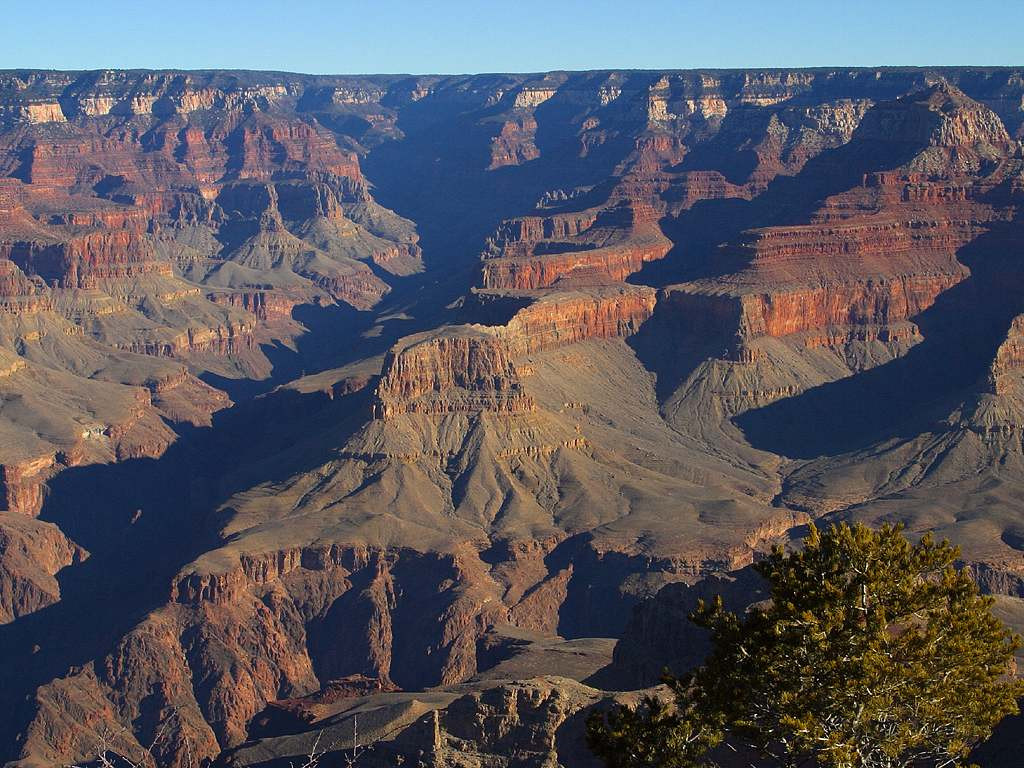 Grand Canyon from Mather Point.
Grand Canyon from Mather Point.
Alt text: The Grand Canyon from Mather Point. Erosion resistance is important in the creation of distinctive geological features.